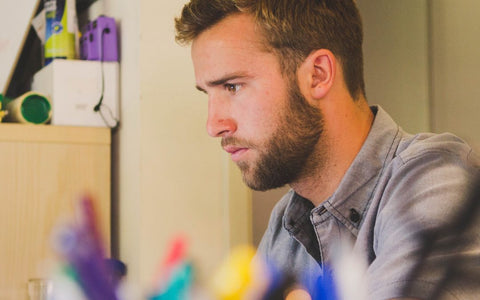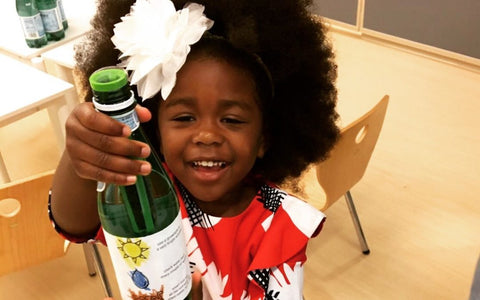Most Urban Gardeners will already appreciate the more obvious benefits of growing their own food; it’s fresher, more nutritious, it tastes better, and you have complete control over how it is produced. But the benefits of living with plants go much further. In fact, interacting with plants has been shown to improve focus & attention, reduce stress & anxiety and enhance physical health. Who knew!
Improved Focus & Attention
Simply being in the presence of plants has been found to improve focus and attention in people of all ages. Researchers have found that symptoms of ADD and ADHD reduce in children after being in green spaces (1). For adults, just having a view of plants has been shown to improve cognitive performance in attention demanding tasks as well as restore attention fatigue (2,3,4,5). The leading theory is that plants provide a restorative view that helps people recover directive attention, and in turn boots mental acuity and productivity.

Reduced Stress & Anxiety
Tough day in the office? Maybe spending time in the garden is what you need! Engaging with plants offers both passive and active benefits, researchers claim:
- Having a view of plants has been shown to improve positive emotions (6), lower anxiety (7,8) and lower perceived stress (9,10)
- In addition to the passive benefits of being in the presence of vegetation, the therapeutic power of gardening also helps with stress reduction. Studies (11) have shown that gardening for 30 minutes does more to reduce stress than reading a book.
Enhanced Physical Health
If Focus, Attention, Stress and Anxiety weren’t enough to convince, what about the possibility of reduced health symptoms?!
- In studies of patients recovering in hospitals, researchers found that people who had been in the presence of plants needed fewer pain killers and were released sooner (12)
- Studies of relatively healthy people in both classrooms (13) and workplaces (14) found 21-34% reduction in health symptoms when people worked in rooms that contained plants
- Positive relationships have also been demonstrated between senior citizens’ longevity and green space (15,16). Perhaps we should be buying grandma a hydroponics kit for Christmas?

The practice of growing plants in buildings is something we as humans have been doing for a very long time. The earliest evidence of humans benefiting from living with plans dates to over 2,000 years ago in Egyptian written history and preserved in the ruins of Pompeii (17). Many believe that as humans we have an innate need to have contact with the natural world (18).
At the end of the day it seems hard to dispute that living with plants is good for us. Here at Urban Leaf our focus is on reconnecting us with our food sources, and encouraging more mindful food choices. If there’s anything we could be doing to make this easier for you, we’d love to hear from you!
References
- A. Faber-Taylor, F.E. Kuo, W.C. Sullivan. Coping with ADD. The surprising connection to green play settings. Environ. Behav., 33 (2001), pp. 54–77
- R. Kaplan, S. Kaplan. The Experience of Nature: A Psychological PerspectiveCambridge University Press, Cambridge (1989)
- T. Hartig, M. Mang, G.W. Evans. Restorative effects of natural environment experiences. Environ. Behav., 23 (1991), pp. 3–26
- T. Hartig, G.W. Evans, L.D. Jamner, D.S. Davis, T. Gärling. Tracking restoration in natural and urban field settings. J. Environ. Psychol., 23 (2003), pp. 109–123
- N.M. Wells. At home with nature. Effects of “greenness” on children’s cognitive functioning. Environ. Behav., 32 (2000), pp. 775–795
- R.S. Ulrich, R.F. Simons, B.D. Losito, E. Fiorito, M.A. Miles, M. Zelson. Stress recovery during exposure to natural and urban environments. Journal of Environmental Psychology, 11 (1991), pp. 201–230
- C.-Y. Chang, P.-K. Chen. Human responses to window views and indoor plants in the workplace. HortScience, 40 (2005), pp. 1354–1359
- S.-H. Park, R.H. Mattson. Effects of flowering and foliage plants in hospital rooms on patients recovering from abdominal surgery. HortTechnology, 18 (2008), pp. 563–568
- K. Dijkstra, M.E. Pieterse, A. Pruyn. Stress-reducing effects of indoor plants in the built healthcare environment: the mediating role of perceived attractiveness. Preventive Medicine (2008)
- E. Kim, R.H. Mattson. Stress recovery effects of viewing red-flowering geraniums. Journal of Therapeutic Horticulture, 13 (2002), pp. 4–12
- Van Den Berg, A. E., & Custers, M. H. G. (2011). Gardening pro- motes neuroendocrine and affective restoration from stress. Journal of Health Psychology, 16, 3-11. doi:10.1177/13591 05310365577
- S.-H. Park, R.H. Mattson. Therapeutic influences of plants in hospital rooms on surgical recovery. HortScience, 44 (2009), pp. 1–4
- Fjeld, T. (2000). The effect of interior planting on health and discomfort among workers and school children. HortTechnology, 10, 46–52
- Fjeld, T., Veiersted, B., Sandvik, L., Riise, G., & Levy, F. (1998). The effect of indoor foliage plants on health and discomfort symptoms among office workers. Indoor and Built Environment, 7, 204–209.
- Tanaka, A., Takano, T., Nakamura, K. and Takeuchi, S. (1996). Health Levels Influenced by Urban Residential Conditions in a Megacity – Tokyo. Urban Studies, 33, 879–894.
- Takano, T., Nakamura, K. and Watanabe, M. (2002). Urban Residential Environments and Senior Citizens‟ Longevity in Mega-city Areas: The Importance of Walkable Green Space. Journal of Epidemiology and Community Health, 56, 12, 913–916.
- G.H. Manaker. Interior plantscapes: Installation, maintenance, and management (3rd ed.)Prentice-Hall, Englewood Cliffs, NJ (1996)
- S.R. Kellert. Building for life: Designing and understanding the human-nature connection. Island Press, Washington, DC (2005)











There are no comments for this article. Be the first one to leave a message!